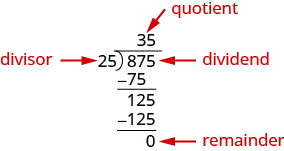 We check division by multiplying the quotient by the divisor.
We check division by multiplying the quotient by the divisor.By the end of this section, you will be able to:
Before you get started, take this readiness quiz.
We are now familiar with all the properties of exponents and used them to multiply polynomials. Next, we’ll use these properties to divide monomials and polynomials.
Find the quotient:
When we divide monomials with more than one variable, we write one fraction for each variable.* * *
Find the quotient:
Find the quotient:
Once you become familiar with the process and have practiced it step by step several times, you may be able to simplify a fraction in one step.
Find the quotient:
Be very careful to simplify
by dividing out a common factor, and to simplify the variables by subtracting their exponents.* * *
Find the quotient:
Find the quotient:
Now that we know how to divide a monomial by a monomial, the next procedure is to divide a polynomial of two or more terms by a monomial.
The method we’ll use to divide a polynomial by a monomial is based on the properties of fraction addition. So we’ll start with an example to review fraction addition. The sum
simplifies to
Now we will do this in reverse to split a single fraction into separate fractions. For example,
can be written
This is the “reverse” of fraction addition and it states that if a, b, and c are numbers where
then
We will use this to divide polynomials by monomials.
To divide a polynomial by a monomial, divide each term of the polynomial by the monomial.
Find the quotient:
Find the quotient:
Find the quotient:
Divide a polynomial by a binomial, we follow a procedure very similar to long division of numbers. So let’s look carefully the steps we take when we divide a 3-digit number, 875, by a 2-digit number, 25.
 We check division by multiplying the quotient by the divisor.
We check division by multiplying the quotient by the divisor.
If we did the division correctly, the product should equal the dividend.
Now we will divide a trinomial by a binomial. As you read through the example, notice how similar the steps are to the numerical example above.
Find the quotient:
 |
|
| Write it as a long division problem. Be sure the dividend is in standard form. |
 |
| Divide by It may help to ask yourself, “What do I need to multiply by to get ?” |
 |
| Put the answer, in the quotient over the term. Multiply times Line up the like terms under the dividend. |
 |
| Subtract from You may find it easier to change the signs and then add. Then bring down the last term, 20. |
 |
Divide by It may help to ask yourself, “What do I need to multiply by to get ?” Put the answer, , in the quotient over the constant term. |
 |
| Multiply 4 times |  |
| Subtract from | 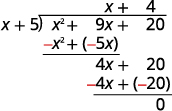 |
| Check: Multiply the quotient by the divisor. You should get the dividend. |
Find the quotient:
Find the quotient:
When we divided 875 by 25, we had no remainder. But sometimes division of numbers does leave a remainder. The same is true when we divide polynomials. In the next example, we’ll have a division that leaves a remainder. We write the remainder as a fraction with the divisor as the denominator.
Look back at the dividends in previous examples. The terms were written in descending order of degrees, and there were no missing degrees. The dividend in this example will be
It is missing an
term. We will add in
as a placeholder.
Find the quotient:
Notice that there is no
term in the dividend. We will add
as a placeholder.
 |
|
| Write it as a long division problem. Be sure the dividend is in standard form with placeholders for missing terms. |  |
| Divide by Put the answer, in the quotient over the term. Multiply times Line up the like terms. Subtract and then bring down the next term. |
 |
| Divide by Put the answer, in the quotient over the term. Multiply times Line up the like terms Subtract and bring down the next term. |
 |
| Divide by Put the answer, in the quotient over the term. Multiply times Line up the like terms. Subtract and bring down the next term. |
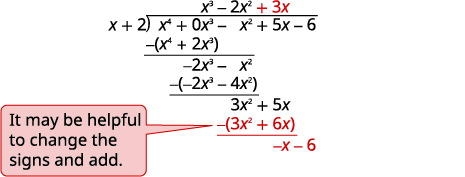 |
| Divide by Put the answer, in the quotient over the constant term. Multiply times Line up the like terms. Change the signs, add. Write the remainder as a fraction with the divisor as the denominator. |
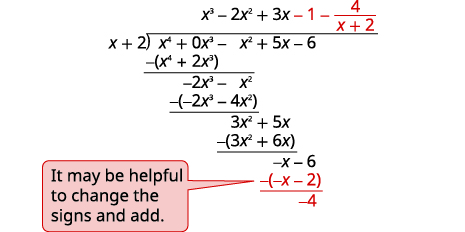 |
| To check, multiply . The result should be |
Find the quotient:
Find the quotient:
In the next example, we will divide by
As we divide, we will have to consider the constants as well as the variables.
Find the quotient:
This time we will show the division all in one step. We need to add two placeholders in order to divide.
| |  |
{: valign=”top”}| |
|
{: valign=”top”}| | 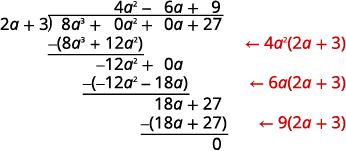 |
{: valign=”top”}{: .unnumbered .unstyled summary=”This image shows the process for polynomial long division using the example 8 a to the third power plus 27 divided by 2 a plus 3. Writing the problem as a long division problem we include placeholders for any missing terms in the dividend. The dividend of 8 a to the third power plus 0 a squared plus 0 a plus 27 is put inside the long division symbol. The divisor of 2 a plus 3 is written to the left of the long division symbol. The quotient is written above the long division symbol. To find the first term in the quotient we divide the 8 a to the third power by 2 a to get 4 a squared. Then multiplying the 4 a squared from the quotient with the entire divisor we get 8 a to the third power plus 12 a squared. This is written below the 8 a to the third power plus 0 a squared in the dividend and subtracted to get negative 12 a squared. The 0 a in the dividend is dropped down to make this negative 12 a squared plus 0 a. To find the next term in the quotient we divide the negative 12 a squared by the 2 a in the divisor to get negative 6 a. The quotient is now 4 a squared minus 6 a. The negative 6 a is multiplied to the entire divisor to get negative 12 a squared minus 18 a. This is subtracted from the negative 12 a squared plus 0 a to give a remainder of 18 a. The 27 in the dividend is dropped down to make this 18 a plus 27. To find the next term in the quotient we divide the 18 a by the 2 a in the divisor to get 9. The quotient is now 4 a squared minus 6 a plus 9. The 9 is multiplied to the entire divisor to get 18 a plus 27. This is subtracted from the 18 a plus 27 to give a remainder of 0. The process can be checked by multiplying the quotient of 4 a squared minus 6 a plus 9 with the divisor of 2 a plus 3 to get the dividend of 8 a cubed plus 27.” data-label=””}
|
{: valign=”top”}{: .unnumbered .unstyled summary=”This image shows the process for polynomial long division using the example 8 a to the third power plus 27 divided by 2 a plus 3. Writing the problem as a long division problem we include placeholders for any missing terms in the dividend. The dividend of 8 a to the third power plus 0 a squared plus 0 a plus 27 is put inside the long division symbol. The divisor of 2 a plus 3 is written to the left of the long division symbol. The quotient is written above the long division symbol. To find the first term in the quotient we divide the 8 a to the third power by 2 a to get 4 a squared. Then multiplying the 4 a squared from the quotient with the entire divisor we get 8 a to the third power plus 12 a squared. This is written below the 8 a to the third power plus 0 a squared in the dividend and subtracted to get negative 12 a squared. The 0 a in the dividend is dropped down to make this negative 12 a squared plus 0 a. To find the next term in the quotient we divide the negative 12 a squared by the 2 a in the divisor to get negative 6 a. The quotient is now 4 a squared minus 6 a. The negative 6 a is multiplied to the entire divisor to get negative 12 a squared minus 18 a. This is subtracted from the negative 12 a squared plus 0 a to give a remainder of 18 a. The 27 in the dividend is dropped down to make this 18 a plus 27. To find the next term in the quotient we divide the 18 a by the 2 a in the divisor to get 9. The quotient is now 4 a squared minus 6 a plus 9. The 9 is multiplied to the entire divisor to get 18 a plus 27. This is subtracted from the 18 a plus 27 to give a remainder of 0. The process can be checked by multiplying the quotient of 4 a squared minus 6 a plus 9 with the divisor of 2 a plus 3 to get the dividend of 8 a cubed plus 27.” data-label=””}
To check, multiply
The result should be
Find the quotient:
Find the quotient:
As we have mentioned before, mathematicians like to find patterns to make their work easier. Since long division can be tedious, let’s look back at the long division we did in [link] and look for some patterns. We will use this as a basis for what is called synthetic division. The same problem in the synthetic division format is shown next.
 Synthetic division basically just removes unnecessary repeated variables and numbers. Here all the
Synthetic division basically just removes unnecessary repeated variables and numbers. Here all the
and
are removed. as well as the
and
as they are opposite the term above.
The first row of the synthetic division is the coefficients of the dividend. The
is the opposite of the 5 in the divisor.
The second row of the synthetic division are the numbers shown in red in the division problem.
The third row of the synthetic division are the numbers shown in blue in the division problem.
Notice the quotient and remainder are shown in the third row.
The following example will explain the process.
Use synthetic division to find the quotient and remainder when
is divided by
| Write the dividend with decreasing powers of |  |
| Write the coefficients of the terms as the first row of the synthetic division. |
 |
| Write the divisor as and place c in the synthetic division in the divisor box. |
 |
| Bring down the first coefficient to the third row. |  |
| Multiply that coefficient by the divisor and place the result in the second row under the second coefficient. |
 |
| Add the second column, putting the result in the third row. |  |
| Multiply that result by the divisor and place the result in the second row under the third coefficient. |
 |
| Add the third column, putting the result in the third row. |  |
| Multiply that result by the divisor and place the result in the third row under the third coefficient. |
 |
| Add the final column, putting the result in the third row. |  |
| The quotient is and the remainder is 2. |
The division is complete. The numbers in the third row give us the result. The
are the coefficients of the quotient. The quotient is
The 2 in the box in the third row is the remainder.
Check:
Use synthetic division to find the quotient and remainder when
is divided by
Use synthetic division to find the quotient and remainder when
is divided by
In the next example, we will do all the steps together.
Use synthetic division to find the quotient and remainder when
is divided by
The polynomial
has its term in order with descending degree but we notice there is no
term. We will add a 0 as a placeholder for the
term. In
form, the divisor is
 We divided a 4th degree polynomial by a 1st degree polynomial so the quotient will be a 3rd degree polynomial.
We divided a 4th degree polynomial by a 1st degree polynomial so the quotient will be a 3rd degree polynomial.
Reading from the third row, the quotient has the coefficients
which is
The remainder* * *
is 0.
Use synthetic division to find the quotient and remainder when
is divided by
Use synthetic division to find the quotient and remainder when
is divided by
Just as polynomials can be divided, polynomial functions can also be divided.
For functions
and
where
For functions
and
find: ⓐ
ⓑ
ⓐ* * *
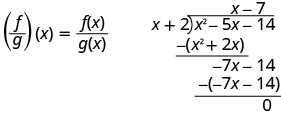
ⓑ In part ⓐ we found
and now are asked to find
For functions
and
find ⓐ
ⓑ
ⓐ
ⓑ
For functions
and
find ⓐ
ⓑ
ⓐ
ⓑ
Let’s look at the division problems we have just worked that ended up with a remainder. They are summarized in the chart below. If we take the dividend from each division problem and use it to define a function, we get the functions shown in the chart. When the divisor is written as
the value of the function at
is the same as the remainder from the division problem.
| Dividend | Divisor |
| Remainder | Function |
| {: valign=”top”} | ———- |
| {: valign=”top”} |
| 4 |
| 4 | |
| {: valign=”top”} |
| 3 |
| 3 | {: valign=”top”}{: summary=”The table has four rows and five columns. The first row is a header row with the headers “dividend”, “Divisor”, “Remainder”, and f of c. The second row contains the expressions x to the fourth power minus x squared plus 5 x minus 6, x minus negative 2, negative 4, f of x equals x to the fourth power minus x squared plus 5 x minus 6, negative 4. The third row contains the expressions 3 x cubed minus 2 x squared minus 10 x plus 8, x minus 2, 4, f of x equals 3 x cubed minus 2 x squared minus 10 x plus 8, 4. The fourth row contains the expressions x to the fourth power minus 16 x squared plus 3 x plus 15, x minus negative 4, 3, f of x equals x to the fourth minus 16 x squared plus 3 x plus 15, 3.”}
To see this more generally, we realize we can check a division problem by multiplying the quotient times the divisor and add the remainder. In function notation we could say, to get the dividend
we multiply the quotient,
times the divisor,
and add the remainder, r.
 |
|
| {: valign=”top”} | If we evaluate this at |
we get: |  |
{: valign=”top”}| |
|
{: valign=”top”}| |  |
{: valign=”top”}| |
|
{: valign=”top”}| |  |
{: valign=”top”}{: .unnumbered .unstyled summary=”The figure shows four equations in function notation. The first equation is f of x equals q of x times the quantity x minus c in parentheses plus r. The second equation replaces x with c. The second equation is f of c equals q of c times the quantity c minus c in parentheses plus r. The third equation simplifies the difference c minus c. The third equation is f of c equals q of c times 0 plus r. The fourth equation simplifies the product q of c times 0. The fourth equation is f of c equals r.” data-label=””}
|
{: valign=”top”}{: .unnumbered .unstyled summary=”The figure shows four equations in function notation. The first equation is f of x equals q of x times the quantity x minus c in parentheses plus r. The second equation replaces x with c. The second equation is f of c equals q of c times the quantity c minus c in parentheses plus r. The third equation simplifies the difference c minus c. The third equation is f of c equals q of c times 0 plus r. The fourth equation simplifies the product q of c times 0. The fourth equation is f of c equals r.” data-label=””}
This leads us to the Remainder Theorem.
If the polynomial function
is divided by
then the remainder is
Use the Remainder Theorem to find the remainder when
is divided by
To use the Remainder Theorem, we must use the divisor in the
form. We can write the divisor
as
So, our
is
To find the remainder, we evaluate
which is
 |
|
| To evaluate substitute |  |
| Simplify. |  |
 |
|
| The remainder is 5 when is divided by | |
| Check: Use synthetic division to check. |
|
 |
|
| The remainder is 5. |
Use the Remainder Theorem to find the remainder when
is divided by
Use the Remainder Theorem to find the remainder when
is divided by
When we divided
by
in [link] the result was
To check our work, we multiply
by
to get
.
Written this way, we can see that
and
are factors of
When we did the division, the remainder was zero.
Whenever a divisor,
divides a polynomial function,
and resulting in a remainder of zero, we say
is a factor of
The reverse is also true. If
is a factor of
then
will divide the polynomial function resulting in a remainder of zero.
We will state this in the Factor Theorem.
For any polynomial function
is a factor of
then
then
is a factor of
Use the Remainder Theorem to determine if
is a factor of
The Factor Theorem tells us that
is a factor of
if
Since
is a factor of
Use the Factor Theorem to determine if
is a factor of
yes
Use the Factor Theorem to determine if
is a factor of
yes
Access these online resources for additional instruction and practice with dividing polynomials.
and
where
is divided by
then the remainder is
is a factor of
then
then
is a factor of
Divide Monomials
In the following exercises, divide the monomials.
Divide a Polynomial by a Monomial
In the following exercises, divide each polynomial by the monomial.
Divide Polynomials using Long Division
In the following exercises, divide each polynomial by the binomial.
Divide Polynomials using Synthetic Division
In the following exercises, use synthetic Division to find the quotient and remainder.
is divided by
is divided by
is divided by
is divided by
is divided by
is divided by
is divided by
is divided by
Divide Polynomial Functions
In the following exercises, divide.
For functions
and
find ⓐ
ⓑ
For functions
and
find ⓐ
ⓑ
ⓐ
ⓑ
For functions
and
find ⓐ
ⓑ
For functions
and
find ⓐ
ⓑ
ⓐ
ⓑ
For functions
and
find ⓐ
ⓑ
For functions
and
find ⓐ
ⓑ
ⓐ
ⓑ
Use the Remainder and Factor Theorem
In the following exercises, use the Remainder Theorem to find the remainder.
is divided by
is divided by
divided by
divided by
−6
In the following exercises, use the Factor Theorem to determine if
is a factor of the polynomial function.
Determine whether
a factor of
Determine whether
a factor of
no
Determine whether
a factor of
Determine whether
a factor of
yes
James divides
by 6 this way:
What is wrong with his reasoning?
Divide
and explain with words how you get each term of the quotient.
answer will vary
Explain when you can use synthetic division.
In your own words, write the steps for synthetic division for
divided by
Answers will vary.
ⓐ After completing the exercises, use this checklist to evaluate your mastery of the objectives of this section
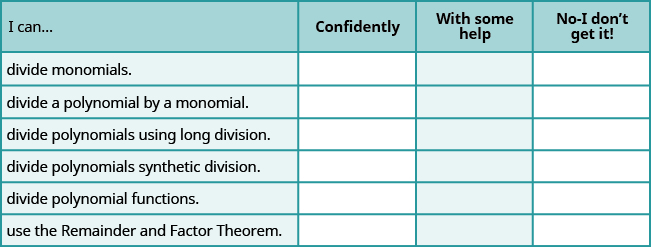 ⓑ On a scale of 1-10, how would you rate your mastery of this section in light of your responses on the checklist? How can you improve this?
ⓑ On a scale of 1-10, how would you rate your mastery of this section in light of your responses on the checklist? How can you improve this?
Determine the Degree of Polynomials
In the following exercises, determine the type of polynomial.
binomial
other polynomial
Add and Subtract Polynomials
In the following exercises, add or subtract the polynomials.
Find the sum of
and
Find the difference of
and
In the following exercises, simplify.
Subtract
from
Find the difference of
and
Evaluate a Polynomial Function for a Given Value of the Variable
In the following exercises, find the function values for each polynomial function.
For the function
find:* * *
ⓐ
ⓑ
ⓒ
ⓐ 165 ⓑ 39 ⓒ 5
For the function
find:* * *
ⓐ
ⓑ
ⓒ
A pair of glasses is dropped off a bridge 640 feet above a river. The polynomial function
gives the height of the glasses t seconds after they were dropped. Find the height of the glasses when
The height is
.
A manufacturer of the latest soccer shoes has found that the revenue received from selling the shoes at a cost of
dollars each is given by the polynomial
Find the revenue received when
dollars.
Add and Subtract Polynomial Functions
In the following exercises, find ⓐ (f + g)(x) ⓑ (f + g)(3) ⓒ (f − g)(x) ⓓ (f − g)(−2)
and
ⓐ
ⓑ
ⓒ
ⓓ
and
Simplify Expressions Using the Properties for Exponents
In the following exercises, simplify each expression using the properties for exponents.
1
Use the Definition of a Negative Exponent
In the following exercises, simplify each expression.
36
In the following exercises, simplify each expression using the Product Property.
In the following exercises, simplify each expression using the Power Property.
In the following exercises, simplify each expression using the Product to a Power Property.
1
In the following exercises, simplify each expression using the Quotient to a Power Property.
In the following exercises, simplify each expression by applying several properties.
In the following exercises, write each number in scientific notation.
5,300,000
In the following exercises, convert each number to decimal form.
In the following exercises, multiply or divide as indicated. Write your answer in decimal form.
Multiply Monomials
In the following exercises, multiply the monomials.
Multiply a Polynomial by a Monomial
In the following exercises, multiply.
Multiply a Binomial by a Binomial
In the following exercises, multiply the binomials using:
ⓐ the Distributive Property ⓑ the FOIL method ⓒ the Vertical Method.
In the following exercises, multiply the binomials. Use any method.
Multiply a Polynomial by a Polynomial
In the following exercises, multiply using ⓐ the Distributive Property ⓑ the Vertical Method.
In the following exercises, multiply. Use either method.
Multiply Special Products
In the following exercises, square each binomial using the Binomial Squares Pattern.
In the following exercises, multiply each pair of conjugates using the Product of Conjugates.
Divide Monomials
In the following exercises, divide the monomials.
Divide a Polynomial by a Monomial
In the following exercises, divide each polynomial by the monomial
Divide Polynomials using Long Division
In the following exercises, divide each polynomial by the binomial.
Divide Polynomials using Synthetic Division
In the following exercises, use synthetic Division to find the quotient and remainder.
is divided by
is divided by
is divided by
Divide Polynomial Functions
In the following exercises, divide.
For functions
and
find ⓐ
ⓑ
ⓐ
ⓑ
For functions
and
find ⓐ
ⓑ
Use the Remainder and Factor Theorem
In the following exercises, use the Remainder Theorem to find the remainder.
is divided by
divided by
In the following exercises, use the Factor Theorem to determine if
is a factor of the polynomial function.
Determine whether
is a factor of
.
no
Determine whether
is a factor of
.
For the polynomial
ⓐ Is it a monomial, binomial, or trinomial? ⓑ What is its degree?
ⓐ trinomial ⓑ 4
Use the Factor Theorem to determine if
a factor of
yes
ⓐ Convert 112,000 to scientific notation. ⓑ Convert
to decimal form.
In the following exercises, simplify and write your answer in decimal form.
For the function
find:* * *
ⓐ
ⓑ
ⓒ
ⓐ
ⓑ
For
and
find* * *
ⓐ
ⓑ
ⓒ
ⓓ
For functions* * *
and* * *
find* * *
ⓐ
ⓑ
ⓐ
ⓑ
A hiker drops a pebble from a bridge 240 feet above a canyon. The function
gives the height of the pebble
seconds after it was dropped. Find the height when

You can also download for free at http://cnx.org/contents/02776133-d49d-49cb-bfaa-67c7f61b25a1@4.13
Attribution: